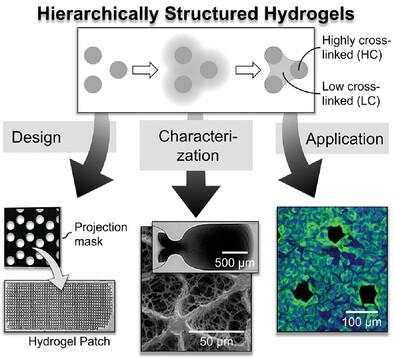分层结构和可调水凝胶贴片:设计、表征和应用
IF 13
2区 材料科学
Q1 CHEMISTRY, MULTIDISCIPLINARY
引用次数: 0
摘要
最近的研究表明,水凝胶的几何形状对于编码、微型机械或组织工程等各种应用非常重要。然而,制造具有微米尺寸特征、先进几何形状和精确控制孔隙率的水凝胶结构仍然具有挑战性。这项研究提出了具有微米级内部偏差区域的分层结构水凝胶,即所谓的水凝胶补丁。这些区域是通过停流光刻技术在一步式高通量制造过程中确定的。在制造过程中,在指定的投影图案之间会形成一个相互连接的交联度较低、孔隙较多的水凝胶网络,从而在补丁内形成至少两种程度的交联。针对两种材料系统和图案变化对补丁形成进行了详细研究,揭示了可靠补丁形成的基本原理。除了两个确定的交联区域外,还通过相应地调整图案在补丁中形成了更多区域。图案几何形状的变化会影响水凝胶补片的机械特性,由于预先确定了压缩点,补片会表现出与图案相关的压缩行为。贴片上的细胞培养是一种可能的应用,它揭示出贴片图案决定了 L929 小鼠成纤维细胞的细胞区域。这些结果介绍了分层结构水凝胶贴片是一种前景广阔的多功能平台系统,具有高度的可定制性。本文章由计算机程序翻译,如有差异,请以英文原文为准。

Hierarchically Structured and Tunable Hydrogel Patches: Design, Characterization, and Application
Recent studies show the importance of hydrogel geometry for various applications, such as encoding, micromachines, or tissue engineering. However, fabricating hydrogel structures with micrometer-sized features, advanced geometry, and precise control of porosity remains challenging. This work presents hierarchically structured hydrogels, so-called hydrogel patches, with internally deviating regions on a micron-scale. These regions are defined in a one-step, high-throughput fabrication process via stop-flow lithography. Between the specified projection pattern during fabrication, an interconnecting lower crosslinked and more porous hydrogel network forms, resulting in at least two degrees of crosslinking within the patches. A detailed investigation of patch formation is performed for two material systems and pattern variations, revealing basic principles for reliable patch formation. In addition to the two defined crosslinked regions, further regions are implemented in the patches by adapting the pattern accordingly. The variations in pattern geometry impact the mechanical characteristics of the hydrogel patches, which display pattern-dependent compression behavior due to predefined compression points. Cell culture on patches, as one possible application, reveals that the patch pattern determines the cell area of L929 mouse fibroblasts. These results introduce hierarchically structured hydrogel patches as a promising and versatile platform system with high customizability.
求助全文
通过发布文献求助,成功后即可免费获取论文全文。
去求助
来源期刊

Small
工程技术-材料科学:综合
CiteScore
17.70
自引率
3.80%
发文量
1830
审稿时长
2.1 months
期刊介绍:
Small serves as an exceptional platform for both experimental and theoretical studies in fundamental and applied interdisciplinary research at the nano- and microscale. The journal offers a compelling mix of peer-reviewed Research Articles, Reviews, Perspectives, and Comments.
With a remarkable 2022 Journal Impact Factor of 13.3 (Journal Citation Reports from Clarivate Analytics, 2023), Small remains among the top multidisciplinary journals, covering a wide range of topics at the interface of materials science, chemistry, physics, engineering, medicine, and biology.
Small's readership includes biochemists, biologists, biomedical scientists, chemists, engineers, information technologists, materials scientists, physicists, and theoreticians alike.
 求助内容:
求助内容: 应助结果提醒方式:
应助结果提醒方式:


